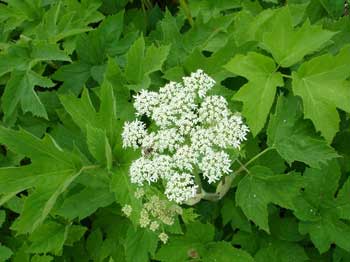Contents:
Common Names | Parts Usually Used | Plant(s) & Culture | Where Found | Medicinal Properties | Biochemical Information
Legends, Myths and Stories | Uses | Formulas or Dosages | Warning | Bibliography
Scientific Names

- Heracleum lanatum L.
- Heracleum maximum L.
- Umbel family
Common Names
- Cow cabbage
- Cow parsnip
- Hogweed
- Madnep
- Madness
- Woolly parsnip
- Youthwort
Parts Usually Used
Seed, rootstock
Back to Top
Description of Plant(s) and
Culture
Masterwort is a large perennial plant; the large fleshy rootstock produces a stout, grooved, woolly stem, often 2 inches thick at the base and 3 to 8 feet high. The thin, hairy leaves are ternately compound and have broad, irregularly toothed leaflets. Large, compound umbels of dull white or purplish flowers appear during June and July. Seeds are flat and blackish, bigger than Dill seeds.
Back to Top
Where Found
Grows on wet ground in Canada and the northern half of the United States.
Back to Top
Medicinal Properties
Antispasmodic, carminative, stimulant
Back to Top
Biochemical Information
Roots contain phototoxic compounds, including psoralen
Back to Top
Legends, Myths and Stories
Masterwort is under investigation for treatment of psoriasis, leukemia, and AIDS.
This plant resembles Angelica and care should be taken in identification of the plant before use. The root of masterwort is hotter than pepper.
Back to Top
Uses
A decoction of masterwort rootstock or seed used for colds, fever, asthma, dyspepsia, colic, dropsy, gout, epilepsy, palsy, apoplexy, expel gas from the bowels, increases the flow of urine, gravel in kidneys, scanty menstruation with painful cramps, and spasmodic problems. Externally, as a wash for wounds, sores, bruises, and ulcers.
Back to Top
Formulas or Dosages
Infusion: take 1 to 2 tsp. in a cup of water per day.
Powdered root: 1 tsp. per day.
Back to Top
Warning
Fresh foliage can produce dermatitis in susceptible individuals. Cattle are reported to have been killed from eating the foliage. Acrid sap can cause blisters on contact.
Back to Top
Bibliography
![]() Back to Eden
Back to Eden, by Jethro Kloss; Back to Eden Publishing Co., Loma Linda, CA 92354, Original copyright 1939, revised edition 1994
![]() American Folk Medicine
American Folk Medicine, by Clarence Meyer, Meyerbooks, publisher, PO Box 427, Glenwood, Illinois 60425, 1973
![]() Culpeper’s Complete Herbal & English Physician: Updated With 117 Modern Herbs
Culpeper’s Complete Herbal & English Physician: Updated With 117 Modern Herbs, by Nicholas Culpeper, Meyerbooks, publisher, PO Box 427, Glenwood, Illinois 60425, 1990, (reprint of 1814)
![]() Eastern/Central Medicinal Plants
Eastern/Central Medicinal Plants, by Steven Foster and James A. Duke., Houghton Mifflin Company, 215 Park Avenue South, New York, NY 10000
![]() The Herb Book
The Herb Book, by John Lust, Bantam Books, 666 Fifth Avenue, New York, NY. copyright 1974.
![]() Indian Herbalogy of North America
Indian Herbalogy of North America, by Alma R. Hutchens, Shambala Publications, Inc., Horticultural Hall, 300 Massachusetts Avenue, Boston, Massachusetts 02115, 1973
![]() Indian Uses of Native Plants
Indian Uses of Native Plants, by Edith Van Allen Murphey, Meyerbooks, publisher, PO Box 427, Glenwood, Illinois 60425, copyright 1958, print 1990
![]() Planetary Herbology
Planetary Herbology, by Michael Tierra, C.A., N.D., O.M.D., Lotus Press, PO Box 325, Twin Lakes. WI 53181., Copyright 1988, published 1992
![]() Webster’s New World Dictionary
Webster’s New World Dictionary, Third College Edition, Victoria Neufeldt, Editor in Chief, New World Dictionaries: A Division of Simon & Schuster, Inc., 15 Columbus Circle, New York, NY 10023
